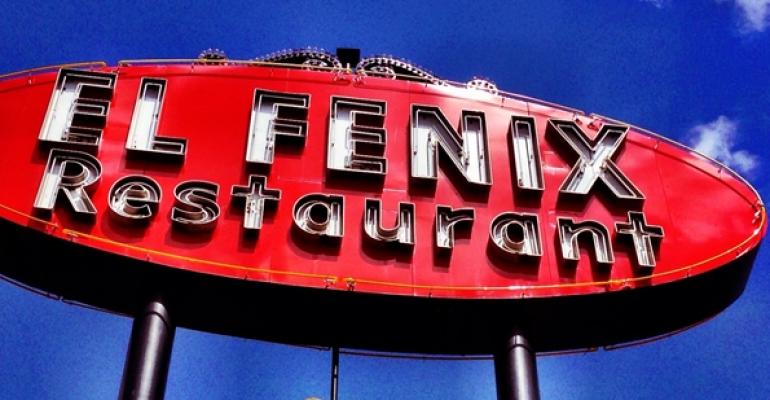The El Fenix restaurant chain, which celebrated its 95th anniversary in September, is proving that even an older concept has sprightly steps on the path to growth.
The popular regional brand was founded in Dallas by Michael “Mike” Martinez in 1918 and acquired by Dallas-based Firebird Restaurant Group LLC in 2008, when it had 15 units.
Firebird has added locations and expanded into other related concepts. It currently has 21 El Fenix restaurants in North Texas and a unit at the Winstar Casino in Oklahoma, as well as two Mexican-inspired Meso Maya units and a La Ventana taqueria.
El Fenix has been known for years for its Tex-Mex menu and Enchilada Wednesdays, which bring lines of guests for its $5.99 special of two cheese enchiladas, rice and beans.
RELATED
• El Fenix chain sold by founding family
• Your Pie eyes growth in Southeast
• More emerging restaurant chains
Firebird Restaurant Group chief executive Mike Karns has been leading a refresh of the El Fenix brand and menus. Karns also owns Sunrise Mexican Foods, which produces Mexican food products such as chips, tortillas, flautas and tamales for retail and foodservice operations.
Karns discussed the historic El Fenix brand and its steady expansion with Nation’s Restaurant News.
What first attracted Firebird to El Fenix?
We saw it as a way to acquire real estate. We prefer to buy. And we like to think each El Fenix location is unique. We don’t have a set prototype. We can get to revenue faster when we pick a great location that’s a little less expensive.

Many of them were 1960s-70s vintage. Not much had been done in 10 or 20 years in some of the stores. So the first thing we did was go around to all 15 locations and picked out the key 'El Fenix' items and what gave it a distinct personality. We boiled that down into a simple, elegant hacienda feel.
How has that been worked into the current models?
It feels less like being in a restaurant than a semi-residential feel. We repackaged those visual clues. We did one store in Irving [Texas] first to see what it would look like, and then we did six expansion stores. We tweaked and tweaked and then figured out how we would go back and remodel.
What are some of the elements?
White stucco iron and tiles and pottery. One of the distinct items is the old Martinez family photos, since 1918, that we were able to repackage and put into the new prototype.
Protecting a legacy
How do you remain sensitive to a 95-year-old restaurant’s heritage?
We have to protect the legacy and not depart from that, while still being an appeal concept to a younger generation. That’s the great balance. We are fortunate to have the legacy, but we have to grow and be relevant and current to the new users coming into the market.
How does that translate to the menu?
We have Tex-Mex classics and specialty items. We also roll out limited-time offers, like a Hatch chile special or a special tamale trio. We’ll continue to add new menu items.
What are the most popular classic menu items?
Cheese enchiladas and rice and beans. Beef enchiladas and tacos. The recipes have been the same for many, many decades.

I looked at the competition, and I saw the same thing in the market, which is basically two items with rice and beans. What we in Texas think is authentic Mexican is actually Tex-Mex. So I wanted to build a true authentic Mexican restaurant and kind of depart from the rest of the crowd and venture out to do something different but yet familiar enough not to scare off guests. The menu has fresh, bold and earthy type of flavors — more seafood, black beans, plantains, moles, roasted chiles.
Does that allow you to run a higher check average?
It does, for sure. There’s also a little higher alcohol mix in the stores as well. The per person average is close to double what El Fenix is.
How do you distinguish the décor package from El Fenix?
The décor is totally different. It’s a simple modern design. The downtown [unit] is in a historic building that has a different vibe.
How do the brands differ in size?
A typical El Fenix is about 6,500 square feet and 200 seats. The downtown [Meso Maya] location is 10,000 [square feet], but we only finished out 5,000 [square feet], which will allow for expansion upstairs with 140 seats.
What’s the most exciting thing for each of the brands going forward?
We’ve refined El Fenix and we have a new model that’s under design. We have a new menu that will protect Tex-Mex classics but have some new items as well. We have slow growth, but we’re looking beyond the Dallas-Fort Worth metroplex and looking for some expansion of El Fenix.
How will you chart that expansion?
It will be tight concentric circles around our base. Meso Maya, we think, is more of a national platform. We may have four stores in the [Fort Worth] metroplex and jump outside to some bigger cities like Chicago and New York and Los Angeles.
Contact Ron Ruggless at [email protected].
Follow him on Twitter: @RonRuggless





